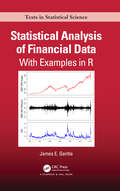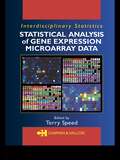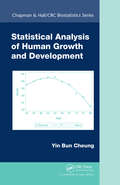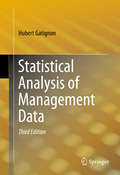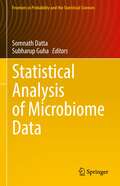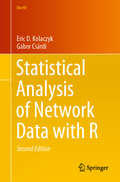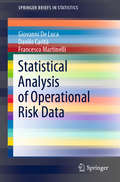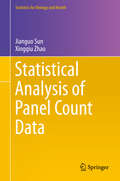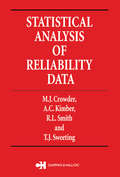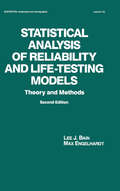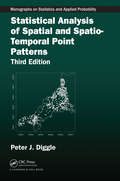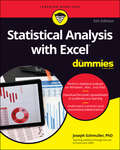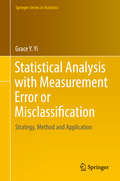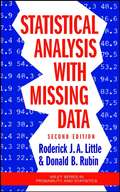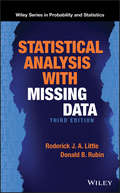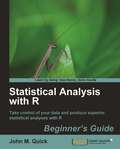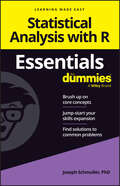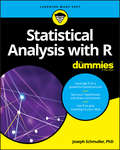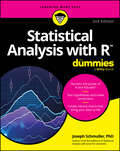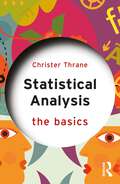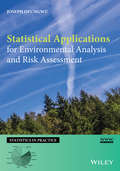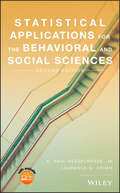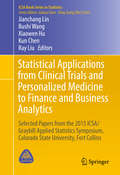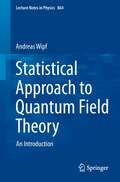- Table View
- List View
Statistical Analysis of Financial Data: With Examples In R (Chapman & Hall/CRC Texts in Statistical Science)
by James GentleStatistical Analysis of Financial Data covers the use of statistical analysis and the methods of data science to model and analyze financial data. The first chapter is an overview of financial markets, describing the market operations and using exploratory data analysis to illustrate the nature of financial data. The software used to obtain the data for the examples in the first chapter and for all computations and to produce the graphs is R. However discussion of R is deferred to an appendix to the first chapter, where the basics of R, especially those most relevant in financial applications, are presented and illustrated. The appendix also describes how to use R to obtain current financial data from the internet. Chapter 2 describes the methods of exploratory data analysis, especially graphical methods, and illustrates them on real financial data. Chapter 3 covers probability distributions useful in financial analysis, especially heavy-tailed distributions, and describes methods of computer simulation of financial data. Chapter 4 covers basic methods of statistical inference, especially the use of linear models in analysis, and Chapter 5 describes methods of time series with special emphasis on models and methods applicable to analysis of financial data. Features * Covers statistical methods for analyzing models appropriate for financial data, especially models with outliers or heavy-tailed distributions. * Describes both the basics of R and advanced techniques useful in financial data analysis. * Driven by real, current financial data, not just stale data deposited on some static website. * Includes a large number of exercises, many requiring the use of open-source software to acquire real financial data from the internet and to analyze it.
Statistical Analysis of Gene Expression Microarray Data (Chapman And Hall/crc Interdisciplinary Statistics Ser.)
by Terry SpeedAlthough less than a decade old, the field of microarray data analysis is now thriving and growing at a remarkable pace. Biologists, geneticists, and computer scientists as well as statisticians all need an accessible, systematic treatment of the techniques used for analyzing the vast amounts of data generated by large-scale gene expression studies
Statistical Analysis of Graph Structures in Random Variable Networks (SpringerBriefs in Optimization)
by V. A. Kalyagin A. P. Koldanov P. A. Koldanov P. M. PardalosThis book studies complex systems with elements represented by random variables. Its main goal is to study and compare uncertainty of algorithms of network structure identification with applications to market network analysis. For this, a mathematical model of random variable network is introduced, uncertainty of identification procedure is defined through a risk function, random variables networks with different measures of similarity (dependence) are discussed, and general statistical properties of identification algorithms are studied. The volume also introduces a new class of identification algorithms based on a new measure of similarity and prove its robustness in a large class of distributions, and presents applications to social networks, power transmission grids, telecommunication networks, stock market networks, and brain networks through a theoretical analysis that identifies network structures. Both researchers and graduate students in computer science, mathematics, and optimization will find the applications and techniques presented useful.
Statistical Analysis of Human Growth and Development (Chapman & Hall/CRC Biostatistics Series)
by Yin Bun CheungStatistical Analysis of Human Growth and Development is an accessible and practical guide to a wide range of basic and advanced statistical methods that are useful for studying human growth and development. Designed for nonstatisticians and statisticians new to the analysis of growth and development data, the book collects methods scattered through
Statistical Analysis of Management Data
by Hubert GatignonStatistical Analysis of Management Data provides a comprehensive approach to multivariate statistical analyses that are important for researchers in all fields of management, including finance, production, accounting, marketing, strategy, technology, and human resources. This book is especially designed to provide doctoral students with a theoretical knowledge of the concepts underlying the most important multivariate techniques and an overview of actual applications. It offers a clear, succinct exposition of each technique with emphasis on when each technique is appropriate and how to use it. This second edition, fully revised, updated, and expanded, reflects the most current evolution in the methods for data analysis in management and the social sciences. In particular, it places a greater emphasis on measurement models, and includes new chapters and sections on: confirmatory factor analysis canonical correlation analysis cluster analysis analysis of covariance structure multi-group confirmatory factor analysis and analysis of covariance structures. Featuring numerous examples, the book may serve as an advanced text or as a resource for applied researchers in industry who want to understand the foundations of the methods and to learn how they can be applied using widely available statistical software.
Statistical Analysis of Microbiome Data (Frontiers in Probability and the Statistical Sciences)
by Somnath Datta Subharup GuhaMicrobiome research has focused on microorganisms that live within the human body and their effects on health. During the last few years, the quantification of microbiome composition in different environments has been facilitated by the advent of high throughput sequencing technologies. The statistical challenges include computational difficulties due to the high volume of data; normalization and quantification of metabolic abundances, relative taxa and bacterial genes; high-dimensionality; multivariate analysis; the inherently compositional nature of the data; and the proper utilization of complementary phylogenetic information. This has resulted in an explosion of statistical approaches aimed at tackling the unique opportunities and challenges presented by microbiome data. This book provides a comprehensive overview of the state of the art in statistical and informatics technologies for microbiome research. In addition to reviewing demonstrably successful cutting-edge methods, particular emphasis is placed on examples in R that rely on available statistical packages for microbiome data. With its wide-ranging approach, the book benefits not only trained statisticians in academia and industry involved in microbiome research, but also other scientists working in microbiomics and in related fields.
Statistical Analysis of Network Data with R (Use R! #65)
by Eric D. Kolaczyk Gábor CsárdiThe new edition of this book provides an easily accessible introduction to the statistical analysis of network data using R. It has been fully revised and can be used as a stand-alone resource in which multiple R packages are used to illustrate how to conduct a wide range of network analyses, from basic manipulation and visualization, to summary and characterization, to modeling of network data. The central package is igraph, which provides extensive capabilities for studying network graphs in R. The new edition of this book includes an overhaul to recent changes in igraph. The material in this book is organized to flow from descriptive statistical methods to topics centered on modeling and inference with networks, with the latter separated into two sub-areas, corresponding first to the modeling and inference of networks themselves, and then, to processes on networks. The book begins by covering tools for the manipulation of network data. Next, it addresses visualization and characterization of networks. The book then examines mathematical and statistical network modeling. This is followed by a special case of network modeling wherein the network topology must be inferred. Network processes, both static and dynamic are addressed in the subsequent chapters. The book concludes by featuring chapters on network flows, dynamic networks, and networked experiments. Statistical Analysis of Network Data with R, 2nd Ed. has been written at a level aimed at graduate students and researchers in quantitative disciplines engaged in the statistical analysis of network data, although advanced undergraduates already comfortable with R should find the book fairly accessible as well.
Statistical Analysis of Operational Risk Data (SpringerBriefs in Statistics)
by Danilo Carità Francesco Martinelli Giovanni De LucaThis concise book for practitioners presents the statistical analysis of operational risk, which is considered the most relevant source of bank risk, after market and credit risk. The book shows that a careful statistical analysis can improve the results of the popular loss distribution approach. The authors identify the risk classes by applying a pooling rule based on statistical tests of goodness-of-fit, use the theory of the mixture of distributions to analyze the loss severities, and apply copula functions for risk class aggregation. Lastly, they assess operational risk data in order to estimate the so-called capital-at-risk that represents the minimum capital requirement that a bank has to hold. The book is primarily intended for quantitative analysts and risk managers, but also appeals to graduate students and researchers interested in bank risks.
Statistical Analysis of Panel Count Data
by Jianguo Sun Xingqiu ZhaoPanel count data occur in studies that concern recurrent events, or event history studies, when study subjects are observed only at discrete time points. By recurrent events, we mean the event that can occur or happen multiple times or repeatedly. Examples of recurrent events include disease infections, hospitalizations in medical studies, warranty claims of automobiles or system break-downs in reliability studies. In fact, many other fields yield event history data too such as demographic studies, economic studies and social sciences. For the cases where the study subjects are observed continuously, the resulting data are usually referred to as recurrent event data. This book collects and unifies statistical models and methods that have been developed for analyzing panel count data. It provides the first comprehensive coverage of the topic. The main focus is on methodology, but for the benefit of the reader, the applications of the methods to real data are also discussed along with numerical calculations. There exists a great deal of literature on the analysis of recurrent event data. This book fills the void in the literature on the analysis of panel count data. This book provides an up-to-date reference for scientists who are conducting research on the analysis of panel count data. It will also be instructional for those who need to analyze panel count data to answer substantive research questions. In addition, it can be used as a text for a graduate course in statistics or biostatistics that assumes a basic knowledge of probability and statistics.
Statistical Analysis of Reliability Data (Chapman And Hall/crc Texts In Statistical Science Ser. #27)
by Martin J. CrowderWritten for those who have taken a first course in statistical methods, this book takes a modern, computer-oriented approach to describe the statistical techniques used for the assessment of reliability.
Statistical Analysis of Reliability and Life-Testing Models: Theory and Methods (Second Edition) (Statistics: Textbooks and Monographs #115)
by Lee BainTextbook for a methods course or reference for an experimenter who is mainly interested in data analyses rather than in the mathematical development of the procedures.
Statistical Analysis of Spatial and Spatio-Temporal Point Patterns (ISSN)
by Peter J. DiggleRetaining all the material from the second edition and adding substantial new material, this third edition presents models and statistical methods for analyzing spatially referenced point process data. Reflected in the title, this edition now covers spatio-temporal point patterns. It also incorporates the use of R through several packages dedicated to the analysis of spatial point process data, with code and data sets available online. Practical examples illustrate how the methods are applied to analyze spatial data in the life sciences.
Statistical Analysis with Excel For Dummies
by Joseph SchmullerBecome a stats superstar by using Excel to reveal the powerful secrets of statistics Microsoft Excel offers numerous possibilities for statistical analysis—and you don’t have to be a math wizard to unlock them. In Statistical Analysis with Excel For Dummies, fully updated for the 2021 version of Excel, you’ll hit the ground running with straightforward techniques and practical guidance to unlock the power of statistics in Excel. Bypass unnecessary jargon and skip right to mastering formulas, functions, charts, probabilities, distributions, and correlations. Written for professionals and students without a background in statistics or math, you’ll learn to create, interpret, and translate statistics—and have fun doing it! In this book you’ll find out how to: Understand, describe, and summarize any kind of data, from sports stats to sales figures Confidently draw conclusions from your analyses, make accurate predictions, and calculate correlations Model the probabilities of future outcomes based on past data Perform statistical analysis on any platform: Windows, Mac, or iPad Access additional resources and practice templates through Dummies.com For anyone who’s ever wanted to unleash the full potential of statistical analysis in Excel—and impress your colleagues or classmates along the way—Statistical Analysis with Excel For Dummies walks you through the foundational concepts of analyzing statistics and the step-by-step methods you use to apply them.
Statistical Analysis with Measurement Error or Misclassification
by Grace Y. YiThis monograph on measurement error and misclassification covers a broad range of problems and emphasizes unique features in modeling and analyzing problems arising from medical research and epidemiological studies. Many measurement error and misclassification problems have been addressed in various fields over the years as well as with a wide spectrum of data, including event history data (such as survival data and recurrent event data), correlated data (such as longitudinal data and clustered data), multi-state event data, and data arising from case-control studies. Statistical Analysis with Measurement Error or Misclassification: Strategy, Method and Application brings together assorted methods in a single text and provides an update of recent developments for a variety of settings. Measurement error effects and strategies of handling mismeasurement for different models are closely examined in combination with applications to specific problems. Readers with diverse backgrounds and objectives can utilize this text. Familiarity with inference methods--such as likelihood and estimating function theory--or modeling schemes in varying settings--such as survival analysis and longitudinal data analysis--can result in a full appreciation of the material, but it is not essential since each chapter provides basic inference frameworks and background information on an individual topic to ease the access of the material. The text is presented in a coherent and self-contained manner and highlights the essence of commonly used modeling and inference methods. This text can serve as a reference book for researchers interested in statistical methodology for handling data with measurement error or misclassification; as a textbook for graduate students, especially for those majoring in statistics and biostatistics; or as a book for applied statisticians whose interest focuses on analysis of error-contaminated data. Grace Y. Yi is Professor of Statistics and University Research Chair at the University of Waterloo. She is the 2010 winner of the CRM-SSC Prize, an honor awarded in recognition of a statistical scientist's professional accomplishments in research during the first 15 years after having received a doctorate. She is a Fellow of the American Statistical Association and an Elected Member of the International Statistical Institute.
Statistical Analysis with Missing Data
by Roderick J. A. Little Donald B. RubinStatistical analysis of data sets with missing values is a pervasive problem for which standard methods are of limited value. The first edition of Statistical Analysis with Missing Data has been a standard reference on missing-data methods. Now, reflecting extensive developments in Bayesian methods for simulating posterior distributions, this Second Edition by two acknowledged experts on the subject offers a thoroughly up-to-date, reorganized survey of current methodology for handling missing-data problems. Blending theory and application, authors Roderick Little and Donald Rubin review historical approaches to the subject and describe rigorous yet simple methods for multivariate analysis with missing values. They then provide a coherent theory for analysis of problems based on likelihoods derived from statistical models for the data and the missing-data mechanism and apply the theory to a wide range of important missing-data problems. The new edition now enlarges its coverage to include: Expanded coverage of Bayesian methodology, both theoretical and computational, and of multiple imputation Analysis of data with missing values where inferences are based on likelihoods derived from formal statistical models for the data-generating and missing-data mechanisms Applications of the approach in a variety of contexts including regression, factor analysis, contingency table analysis, time series, and sample survey inference Extensive references, examples, and exercises Amstat News asked three review editors to rate their top five favorite books in the September 2003 issue. Statistical Analysis With Missing Data was among those chosen.
Statistical Analysis with Missing Data (Wiley Series in Probability and Statistics #333)
by Donald B. Rubin Roderick J. LittleAN UP-TO-DATE, COMPREHENSIVE TREATMENT OF A CLASSIC TEXT ON MISSING DATA IN STATISTICS The topic of missing data has gained considerable attention in recent decades. This new edition by two acknowledged experts on the subject offers an up-to-date account of practical methodology for handling missing data problems. Blending theory and application, authors Roderick Little and Donald Rubin review historical approaches to the subject and describe simple methods for multivariate analysis with missing values. They then provide a coherent theory for analysis of problems based on likelihoods derived from statistical models for the data and the missing data mechanism, and then they apply the theory to a wide range of important missing data problems. Statistical Analysis with Missing Data, Third Edition starts by introducing readers to the subject and approaches toward solving it. It looks at the patterns and mechanisms that create the missing data, as well as a taxonomy of missing data. It then goes on to examine missing data in experiments, before discussing complete-case and available-case analysis, including weighting methods. The new edition expands its coverage to include recent work on topics such as nonresponse in sample surveys, causal inference, diagnostic methods, and sensitivity analysis, among a host of other topics. An updated "classic" written by renowned authorities on the subject Features over 150 exercises (including many new ones) Covers recent work on important methods like multiple imputation, robust alternatives to weighting, and Bayesian methods Revises previous topics based on past student feedback and class experience Contains an updated and expanded bibliography Statistical Analysis with Missing Data, Third Edition is an ideal textbook for upper undergraduate and/or beginning graduate level students of the subject. It is also an excellent source of information for applied statisticians and practitioners in government and industry.
Statistical Analysis with R
by John M. QuickThis is a practical, step by step guide that will help you to quickly become proficient in the data analysis using R. The book is packed with clear examples, screenshots, and code to carry on your data analysis without any hurdle.If you are a data analyst, business or information technology professional, student, educator, researcher, or anyone else who wants to learn to analyze the data effectively then this book is for you.No prior experience with R is necessary. Knowledge of other programming languages, software packages, or statistics may be helpful, but is not required.
Statistical Analysis with R Essentials For Dummies
by Joseph SchmullerThe easy way to get started coding and analyzing data in the R programming language Statistical Analysis with R Essentials For Dummies is your reference to all the core concepts about R—the widely used, open-source programming language and data analysis tool. This no-nonsense book gets right to the point, eliminating review material, wordy explanations, and fluff. Understand all you need to know about the foundations of R, swiftly and clearly. Perfect for a brush-up on the basics or as an everyday desk reference on the job, this is the reliable little book you can always turn to for answers. Get a quick and thorough intro to the basic concepts of coding for data analysis in R Review what you've already learned or pick up essential new skills Perform statistical analysis for school, business, and beyond with R programming Keep this concise reference book handy for jogging your memory as you work This book is to the point, focusing on the key topics readers need to know about this popular programming language. Great for supplementing classroom learning, reviewing for a certification, or staying knowledgeable on the job.
Statistical Analysis with R For Dummies
by Joseph SchmullerUnderstanding the world of R programming and analysis has never been easier Most guides to R, whether books or online, focus on R functions and procedures. But now, thanks to Statistical Analysis with R For Dummies, you have access to a trusted, easy-to-follow guide that focuses on the foundational statistical concepts that R addresses—as well as step-by-step guidance that shows you exactly how to implement them using R programming. People are becoming more aware of R every day as major institutions are adopting it as a standard. Part of its appeal is that it's a free tool that's taking the place of costly statistical software packages that sometimes take an inordinate amount of time to learn. Plus, R enables a user to carry out complex statistical analyses by simply entering a few commands, making sophisticated analyses available and understandable to a wide audience. Statistical Analysis with R For Dummies enables you to perform these analyses and to fully understand their implications and results. Gets you up to speed on the #1 analytics/data science software tool Demonstrates how to easily find, download, and use cutting-edge community-reviewed methods in statistics and predictive modeling Shows you how R offers intel from leading researchers in data science, free of charge Provides information on using R Studio to work with R Get ready to use R to crunch and analyze your data—the fast and easy way!
Statistical Analysis with R For Dummies
by Joseph SchmullerSimplify stats and learn how to graph, analyze, and interpret data the easy way Statistical Analysis with R For Dummies makes stats approachable by combining clear explanations with practical applications. You'll learn how to download and use R and RStudio—two free, open-source tools—to learn statistics concepts, create graphs, test hypotheses, and draw meaningful conclusions. Get started by learning the basics of statistics and R, calculate descriptive statistics, and use inferential statistics to test hypotheses. Then, visualize it all with graphs and charts. This Dummies guide is your well-marked path to sailing through statistics. Get clear explanations of the basics of statistics and data analysis Learn how to analyze and visualize data with R, step by step Create charts, graphs, and summaries to interpret results Explore hypothesis testing, and prediction techniques This is the perfect introduction to R for students, professionals, and the stat-curious.
Statistical Analysis: The Basics (The Basics)
by Christer ThraneStatistical Analysis: The Basics provides an engaging and easy‑to‑read primer on this sometimes daunting subject. Intended for those with little or no background in mathematics or statistics, this book explores the importance of statistical analysis in the modern world by asking statistical questions about data and explains how to conduct such analyses and correctly interpret the results.Packed with everyday examples from sport, health, education, and leisure, it reinforces the understanding of core topics while avoiding the heavy use of equations and formulae. Written in a highly accessible style and adopting a hands‑on approach, each chapter is accompanied by a summary of key points, illustrations and tables, and recommendations for further reading, with the final chapter delving into the practicalities of conducting a real‑life statistical research project.Statistical Analysis: The Basics is essential reading for anyone who wishes to master the fundamentals of modern‑day statistical analysis.
Statistical Applications for Environmental Analysis and Risk Assessment
by Joseph OfungwuStatistical Applications for Environmental Analysis and Risk Assessment guides readers through real-world situations and the best statistical methods used to determine the nature and extent of the problem, evaluate the potential human health and ecological risks, and design and implement remedial systems as necessary. Featuring numerous worked examples using actual data and "ready-made" software scripts, Statistical Applications for Environmental Analysis and Risk Assessment also includes:* Descriptions of basic statistical concepts and principles in an informal style that does not presume prior familiarity with the subject* Detailed illustrations of statistical applications in the environmental and related water resources fields using real-world data in the contexts that would typically be encountered by practitioners* Software scripts using the high-powered statistical software system, R, and supplemented by USEPA's ProUCL and USDOE's VSP software packages, which are all freely available* Coverage of frequent data sample issues such as non-detects, outliers, skewness, sustained and cyclical trend that habitually plague environmental data samples* Clear demonstrations of the crucial, but often overlooked, role of statistics in environmental sampling design and subsequent exposure risk assessment.
Statistical Applications for the Behavioral and Social Sciences
by Laurence G. Grimm K. Paul Nesselroade JrAn updated edition of a classic text on applying statistical analyses to the social sciences, with reviews, new chapters, an expanded set of post-hoc analyses, and information on computing in Excel and SPSS Now in its second edition,Statistical Applications for the Behavioral and Social Sciences has been revised and updated and continues to offer an essential guide to the conceptual foundations of statistical analyses (particularly inferential statistics), placing an emphasis on connecting statistical tools with appropriate research contexts. Designed to be accessible, the text contains an applications-oriented, step-by-step presentation of the statistical theories and formulas most often used by the social sciences. The revised text also includes an entire chapter on the basic concepts in research, presenting an overall context for all the book’s statistical theories and formulas. The authors cover descriptive statistics and z scores, the theoretical underpinnings of inferential statistics, z and t tests, power analysis, one/two-way and repeated-measures ANOVA, linear correlation and regression, as well as chi-square and other nonparametric tests. The second edition also includes a new chapter on basic probability theory. This important resource: • Contains information regarding the use of statistical software packages; both Excel and SPSS • Offers four strategically positioned and accumulating reviews, each containing a set of research-oriented diagnostic questions designed to help students determine which tests are applicable to which research scenarios • Incorporates additional statistical information on follow-up analyses such as post-hoc tests and effect sizes • Includes a series of sidebar discussions dispersed throughout the text that address, among other topics, the recent and growing controversy regarding the failed reproducibility of published findings in the social sciences • Puts renewed emphasis on presentation of data and findings using the APA format • Includes supplementary material consisting of a set of “kick-start” quizzes designed to get students quickly back up to speed at the start of an instructional period, and a complete set of ready-to-use PowerPoint slides for in-class use Written for students in areas such as psychology, sociology, criminology, political science, public health, and others, Statistical Applications for the Behavioral and Social Sciences, Second Edition continues to provide the information needed to understand the foundations of statistical analyses as relevant to the behavioral and social sciences.
Statistical Applications from Clinical Trials and Personalized Medicine to Finance and Business Analytics
by Jianchang Lin Bushi Wang Xiaowen Hu Kun Chen Ray LiuThe papers in this volume represent a broad, applied swath of advanced contributions to the 2015 ICSA/Graybill Applied Statistics Symposium of the International Chinese Statistical Association, held at Colorado State University in Fort Collins. The contributions cover topics that range from statistical applications in business and finance to applications in clinical trials and biomarker analysis. Each papers was peer-reviewed by at least two referees and also by an editor. The conference was attended by over 400 participants from academia, industry, and government agencies around the world, including from North America, Asia, and Europe.
Statistical Approach to Quantum Field Theory
by Andreas WipfOver the past few decades the powerful methods of statistical physics and Euclidean quantum field theory have moved closer together, with common tools based on the use of path integrals. The interpretation of Euclidean field theories as particular systems of statistical physics has opened up new avenues for understanding strongly coupled quantum systems or quantum field theories at zero or finite temperatures. Accordingly, the first chapters of this book contain a self-contained introduction to path integrals in Euclidean quantum mechanics and statistical mechanics. The resulting high-dimensional integrals can be estimated with the help of Monte Carlo simulations based on Markov processes. The most commonly used algorithms are presented in detail so as to prepare the reader for the use of high-performance computers as an "experimental" tool for this burgeoning field of theoretical physics. Several chapters are then devoted to an introduction to simple lattice field theories and a variety of spin systems with discrete and continuous spins, where the ubiquitous Ising model serves as an ideal guide for introducing the fascinating area of phase transitions. As an alternative to the lattice formulation of quantum field theories, variants of the flexible renormalization group methods are discussed in detail. Since, according to our present-day knowledge, all fundamental interactions in nature are described by gauge theories, the remaining chapters of the book deal with gauge theories without and with matter. This text is based on course-tested notes for graduate students and, as such, its style is essentially pedagogical, requiring only some basics of mathematics, statistical physics, and quantum field theory. Yet it also contains some more sophisticated concepts which may be useful to researchers in the field. Each chapter ends with a number of problems - guiding the reader to a deeper understanding of some of the material presented in the main text - and, in most cases, also features some listings of short, useful computer programs.
